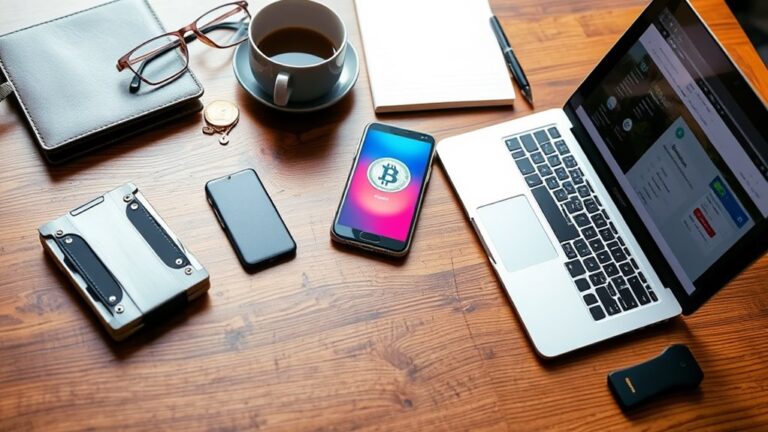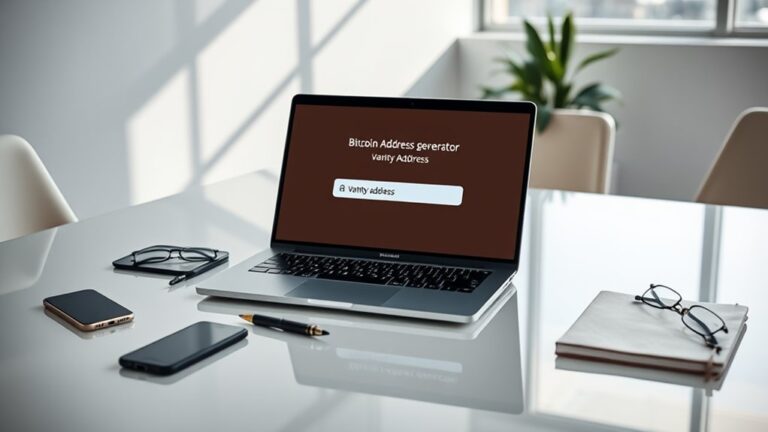
Bitcoin Wallet Setup for Beginners
Setting up a Bitcoin wallet involves understanding the types available, such as hot wallets for convenience and cold wallets for security. Users should prioritize wallets with strong security features and support for private key ownership. It is essential to follow proper setup procedures, secure the account with two-factor authentication, and keep a backup of the seed phrase. By considering costs and transaction fees, users can effectively manage their wallet while ensuring safety. More information on optimizing wallet security is available.
Table of Contents
Key Takeaways
- Choose a wallet type (hot or cold) based on your needs for convenience or security before starting the setup process.
- Download wallet software from official sources to ensure security and protect your funds from potential threats.
- Create a strong, unique password and store your generated seed phrase in a secure location for wallet recovery purposes.
- Fund your wallet by transferring Bitcoin or using integrated exchange services after completing the setup.
- Enable two-factor authentication to enhance security and keep your wallet updated to protect against vulnerabilities.
Understanding Bitcoin Wallet Types

Bitcoin wallets serve as essential tools for managing and securing digital assets. There are various types of wallets, each serving unique purposes.
Hot wallets, such as mobile, desktop, and web wallets, connect to the internet, offering convenience for everyday transactions but posing risks of cyberattacks. Examples include Coinbase Wallet and Crypto.com DeFi Wallet.
Hot wallets, including mobile and web options, provide convenience for transactions but come with cyberattack risks.
In contrast, cold wallets, which include hardware wallets like Ledger and Trezor, store Bitcoin offline, providing enhanced security for long-term storage. Paper wallets also fall under this category but are less practical for frequent use.
Software wallets, like Electrum, store private keys on devices, while web wallets require trust in third-party services accessed via browsers. Understanding wallet features is vital for effective Bitcoin management.
Selecting the Right Wallet for You
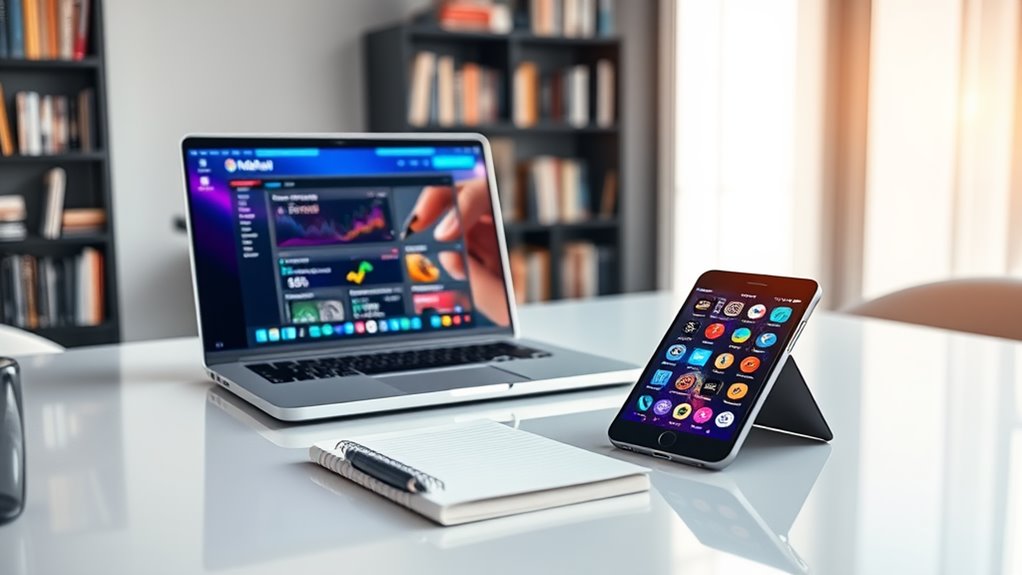
Choosing the right wallet can significantly impact a user’s experience with managing Bitcoin and other cryptocurrencies. Users should prioritize wallets with strong security features, such as two-factor authentication and private key control.
Non-custodial wallets provide users with ownership of their private keys, enhancing security. Additionally, open-source wallets, like Electrum, offer transparency and community scrutiny.
For usability, a user-friendly interface, accessible customer support, and clear instructions are crucial. Users should consider wallet types based on their needs, such as hot wallets for frequent transactions or cold wallets for long-term storage.
Finally, evaluating costs, transaction fees, and compatibility with multiple devices guarantees a wallet aligns with individual preferences, supporting a seamless cryptocurrency experience. Understanding the differences between wallet types can also help users make informed decisions tailored to their specific needs.
Step-by-Step Guide to Setting Up a Hot Wallet
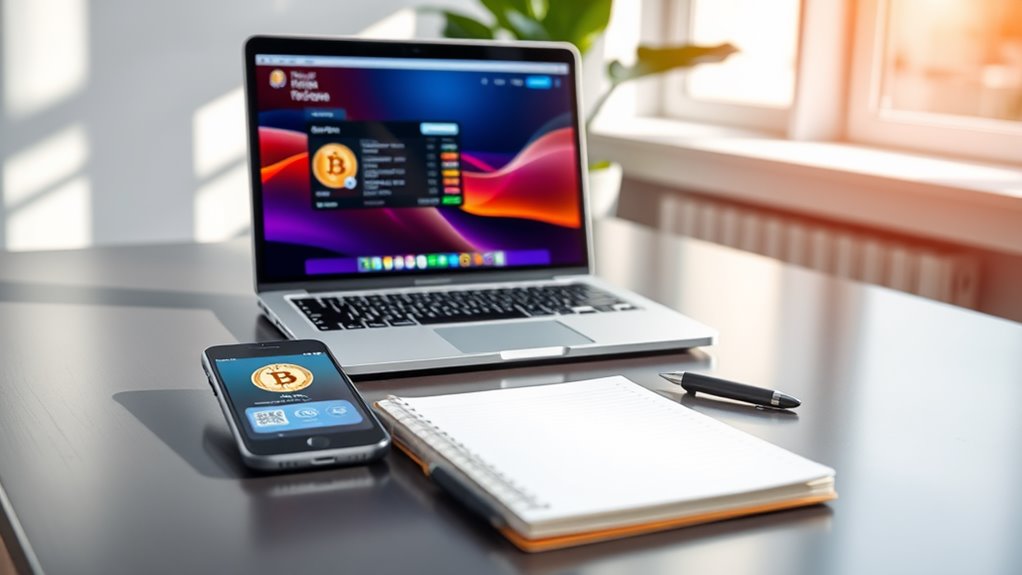
Setting up a hot wallet can be a straightforward process, especially for those new to cryptocurrency. First, users should download wallet software from official sources to guarantee security.
After installation, creating an account involves providing necessary information, including a strong password. Next, the wallet generates a seed phrase, which is essential for recovery; this must be stored securely.
Once set up, users can fund the wallet by transferring Bitcoin from another wallet or using integrated exchange services. To enhance security, enabling features like two-factor authentication is recommended.
Regular updates are also important to protect against vulnerabilities. Additionally, choosing a wallet app with secure features can greatly improve the safety of your funds. Following these steps allows users to manage their Bitcoin transactions conveniently while being mindful of security considerations.
Step-by-Step Guide to Setting Up a Cold Wallet
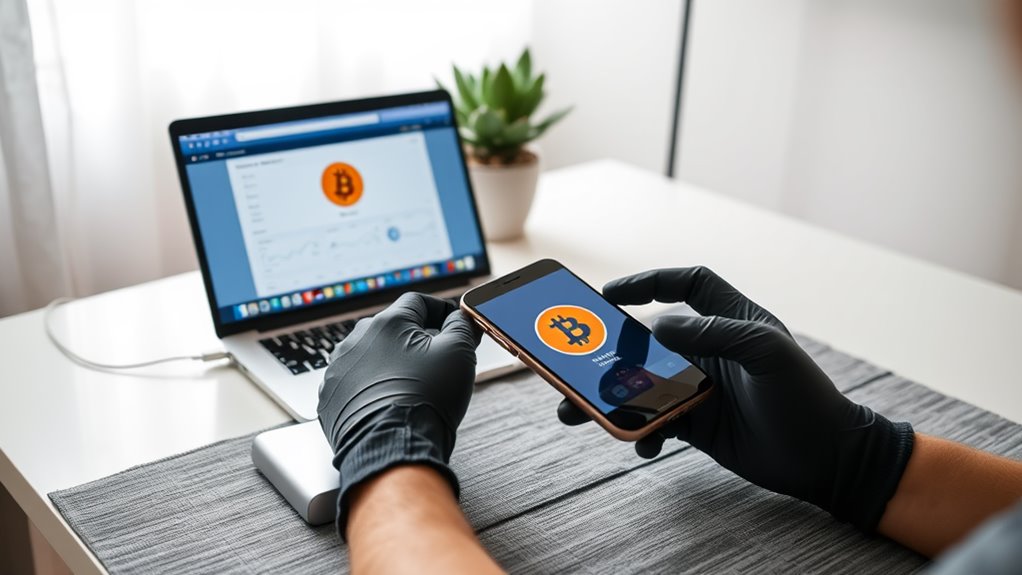
For individuals looking to securely store their cryptocurrency, setting up a cold wallet is a highly effective method.
First, purchase a reputable cold wallet, such as a hardware wallet from trusted manufacturers like Ledger or Trezor, ensuring it is compatible with the desired cryptocurrency.
Next, follow the manufacturer’s instructions to initialize the device, creating a secure PIN and backup seed phrase. Store this seed phrase in a fireproof, secure location.
To transfer funds, locate the cold wallet’s public address, then log into your cryptocurrency exchange, navigate to the withdrawal section, and enter the address.
Verify all transaction details before confirming the transfer. Keeping the wallet offline minimizes hacking risks and enhances overall security for long-term asset storage. Additionally, be aware of essential tips to safeguard your Bitcoin from scams and hacks, as these can significantly affect your investment.
Essential Security Features to Enable
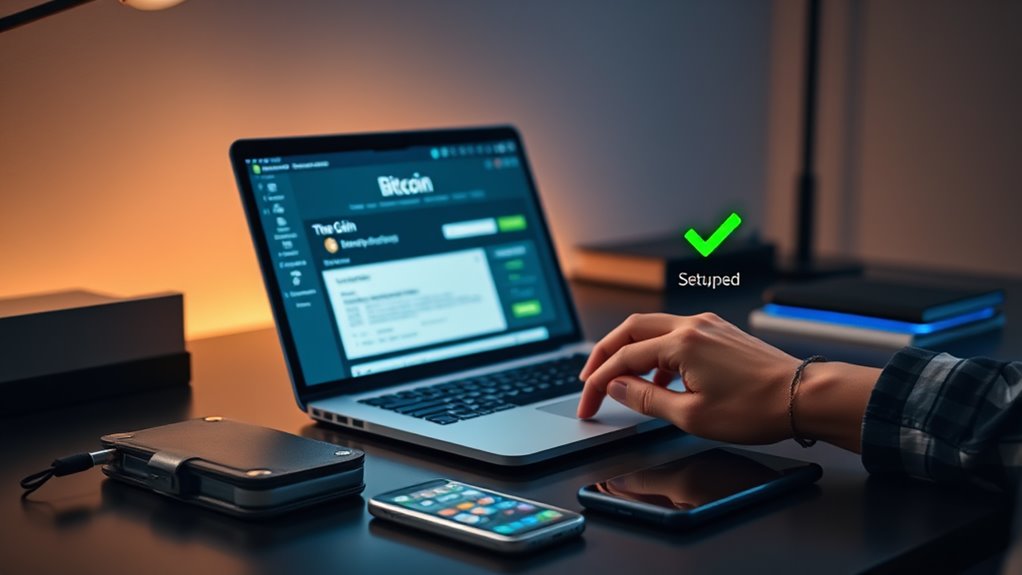
Security features play an essential role in safeguarding cryptocurrency wallets from potential threats. Multi-Factor Authentication (MFA) enhances security by requiring multiple forms of verification, while Two-Factor Authentication (2FA) adds an extra layer through a password and token.
Effective security measures, like Multi-Factor and Two-Factor Authentication, are crucial for protecting cryptocurrency wallets from threats.
Biometric Authentication, using fingerprints or facial recognition, provides convenient access and protection. Users should prioritize unique, complex passwords, potentially utilizing password management tools.
Secure communication protocols, like TLS/SSL encryption, protect data during transmission, while using Virtual Private Networks (VPNs) adds an extra layer of security on public networks.
Regular security audits and user education about phishing threats are critical in maintaining wallet integrity. Additionally, selecting exchanges that are secure and regulated can further enhance the overall safety of your cryptocurrency holdings.
Finally, employing cold wallets or hardware wallets guarantees private keys remain secure against online threats.
Managing Costs and Fees Associated With Wallets

Managing costs and fees associated with Bitcoin wallets is essential for users seeking to maximize their investments.
Transaction fees can vary greatly based on factors such as network congestion and the type of wallet used, whether it be hardware or software.
Understanding these fees, along with any potential charges from wallet providers, can help users make informed choices and optimize their overall experience in the Bitcoin ecosystem. Additionally, knowing how Bitcoin fees are calculated can help users choose the best times to make transactions to reduce costs.
Understanding Transaction Fees
How do transaction fees impact Bitcoin users? Transaction fees play a critical role in ensuring that Bitcoin transactions are processed effectively on the blockchain. These fees vary based on transaction size, network demand, and can fluctuate during periods of high activity.
Understanding transaction fees is essential for users to manage costs effectively.
- Transaction fees incentivize miners to validate transactions.
- Fees are influenced by network congestion and block size limitations.
- Users can utilize fee calculators to estimate ideal fees.
- Setting higher fees can expedite transaction processing.
- Batching smaller transactions can reduce overall costs.
- Understanding the fee structure of blockchains helps users make informed decisions regarding their transactions.
Hardware Wallet Expenses
Investing in a hardware wallet involves various costs that users should consider before making a purchase. The initial purchase price typically ranges from $50 to $200, depending on the brand and features.
Popular brands like Ledger and Trezor offer varying functionalities, often including secure element chips for enhanced security. Users must also consider ongoing expenses, such as potential purchases for accessories and backup solutions.
While firmware updates are usually free, additional security measures may incur costs. If a wallet is lost or damaged, replacing it becomes necessary to access funds.
Software Wallet Charges
When exploring software wallet charges, it is essential to understand the various fees that can impact users. These charges can vary greatly based on several factors, influencing the overall cost of using a wallet.
- Network fees for transaction validation
- Customizable fees for speed preferences
- Fee estimation tools for optimizing costs
- Exchange fees for transaction facilitation
- Batching options to reduce per-transaction fees
Users typically do not incur wallet-specific charges, but they must pay network fees. The speed of transactions often correlates with the fees paid; higher fees result in faster processing. Additionally, understanding U.S. tax regulations can help users navigate potential implications of cryptocurrency transactions on their financial obligations.
Best Practices for Keeping Your Wallet Secure

To keep a Bitcoin wallet secure, users should follow several best practices.
First, creating strong and unique passwords is essential to prevent unauthorized access. Additionally, enabling two-factor authentication and regularly backing up the seed phrase can further enhance the security of the wallet. Always be cautious of phishing attacks, as these can compromise your wallet and personal information.
Use Strong Passwords
A strong password is an essential component of securing a Bitcoin wallet. It protects against unauthorized access and potential theft.
To create an effective password, users should consider the following guidelines:
- Length: Aim for at least 12 characters; 16 is even better.
- Character Mix: Use uppercase and lowercase letters, numbers, and special characters.
- Avoid Personal Info: Do not include easily guessable information, such as names or birthdays.
- Unpredictable Passphrases: Create memorable yet random phrases to enhance security.
- No Patterns: Steer clear of predictable sequences like “12345” or “abcdef”.
Enable Two-Factor Authentication
Enabling two-factor authentication (2FA) is a critical step in enhancing the security of a Bitcoin wallet, as it adds an additional layer of protection beyond just a password. 2FA requires two forms of identification, making unauthorized access considerably more difficult for cybercriminals. Common methods include SMS codes, mobile authenticator apps, and hardware tokens.
| 2FA Method | Security Level |
|---|---|
| SMS | Moderate |
| Google Authenticator | High |
| YubiKey | Very High |
| Biometric Verification | High |
While 2FA improves security, users should remain aware of risks like phishing attacks and SIM swapping. Choosing a reliable method and testing the setup guarantees better protection for cryptocurrency assets.
Regularly Backup Seed Phrase
Backing up a Bitcoin wallet’s seed phrase is vital for safeguarding access to cryptocurrency funds. A seed phrase, typically composed of 12 to 24 words, acts as a master key to restore wallet access on any device.
Consequently, proper backup and storage methods are essential to avoid permanent loss or theft.
- Digital Vaults: Encrypted and distributed backups.
- Metal Backups: Durability against physical damage.
- Encrypted Local Drives: Secure but needs careful key management.
- Hardware Wallets: Additional security but require setup.
- Paper Wallets: Simple yet susceptible to environmental threats.
Storing seed phrases securely prevents unauthorized access and guarantees long-term preservation, emphasizing the importance of regular backups in maintaining cryptocurrency security.
Frequently Asked Questions
Can I Use Multiple Wallets Simultaneously?
Yes, utilizing multiple wallets simultaneously is feasible. This approach enhances asset diversification, improves security by limiting risks, and offers flexibility for managing various cryptocurrencies, ultimately leading to better organization and convenience in financial activities.
What Happens if I Lose My Wallet Device?
Losing a wallet device can result in permanent loss of access to funds. An estimated 17-25% of mined Bitcoins are already lost, underscoring the importance of secure backups and proper wallet management to prevent such scenarios.
Are Bitcoin Wallets Insured Against Theft?
Bitcoin wallets generally lack insurance against theft. While some exchanges offer limited coverage for hot wallets, most policies exclude losses from user error, emphasizing the necessity for secure management and additional protective measures.
Can I Transfer Bitcoin From a Hot Wallet to a Cold Wallet?
Amidst a digital landscape, transferring Bitcoin from a hot wallet to a cold wallet is possible. This process enhances security by moving assets offline, ensuring protection against potential threats lurking in the online domain.
Is There a Limit to How Much Bitcoin I Can Store?
There is no inherent limit to how much Bitcoin can be stored in a wallet. Storage capacity is determined by the wallet’s technical capabilities, and Bitcoin itself can be divided into smaller units for transactions.
Conclusion
In summary, setting up a Bitcoin wallet involves a careful selection between hot and cold options, each offering distinct advantages and risks. While hot wallets provide convenience for frequent transactions, cold wallets emphasize security for long-term storage. Understanding these differences is vital for effective cryptocurrency management. By implementing essential security features and adhering to best practices, users can safeguard their assets against potential threats. Ultimately, informed choices lead to a balanced approach in the evolving landscape of digital currency.


